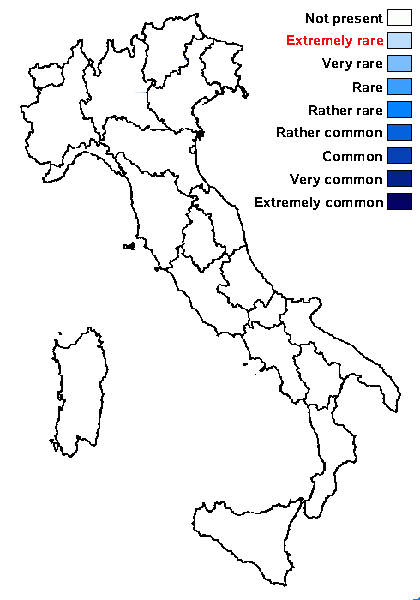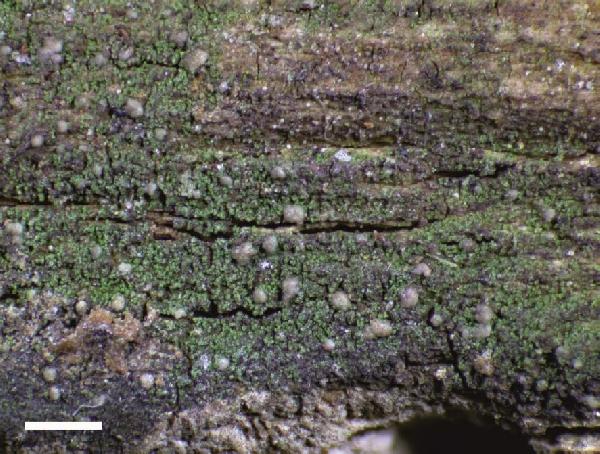Micarea fallax Launis & Myllys
in Launis & al., Mycologia, 111, 4: 579, 2019.
Synonyms:
Distribution:
Description: Thallus crustose, episubstratic, bright green or pale to dark olive-green, granular, composed of 20-40 µm wide goniocysts which often coalesce into larger granules, forming a more or less thick, almost continuous to cracked crust, if less developed warted-granular, small-areolate, or membranous and more or less shiny. Crystals visible under polarized light often present in the thallus. Apothecia micareoid, emarginate, usually numerous, 0.2-0.4(-0.5) mm across, cream-white to pale brown, sometimes with a pale greyish tinge, usually hemispherical or subglobose, sometimes adnate or convex and semi-immersed in the thallus, simple or tuberculate. Proper exciple inconspicuous, poorly evident; epithecium colourless, pale grey or pale brown, the pigmented parts K+ violet, without crystals; hymenium colourless, c. 35-45 µm high, with crystals visible under polarized light; paraphyses numerous, branched and anastomosing, 0.5-1(-1.5) µm thick at mid-level, the apical cells hardly wider; hypothecium colourless or yellowish. Asci 8-spored, clavate, in K/I with a blue outer layer and apical dome and unstained wall, the dome with an apical cushion, 28-38 x 10-13 µm. Ascospores simple or 1-septate, hyaline, oblong-ellipsoid or obovoid, 8-11 x 3-4 µm. Pycnidia whitish, the wall K- and C-, of 2 types: a) mesopycnidia, small and usually inconspicuous, 50-100 µm wide, sessile or mostly semi-immersed, globose or barrel-shaped, sometimes with an extruding white conidial mass, producing cylindrical or cylindrical-fusiform mesoconidia measuring (4-)4.5-5.5(-6) x 1-1.5 µm, b) micropycnidia, small and inconspicuous, immersed, globose, 40-80 µm wide, producing straight or sometimes curved, bacilliform or narrowly fusiform microconidia measuring 5.5-7.5 x c. 1 µm. Photobiont micareoid, the cells 4.5-7 µm wide. Spot tests: thallus K-, C-, KC-, P-, UV-; pigmented parts of apothecia K+ violet. Chemistry: micareic acid; apothecia with the Sedifolia-grey pigment.Note: a recently-described species growing on the acid bark of coniferous and deciduous trees, more rarely on lignum, widespread in Northern and Central Europe. To be looked for in Italy, especially in the Alps.
Growth form: Crustose
Substrata: bark
Photobiont: green algae other than Trentepohlia
Reproductive strategy: mainly sexual

Predictive model
Growth form: Crustose
Substrata: bark
Photobiont: green algae other than Trentepohlia
Reproductive strategy: mainly sexual

Predictive model


